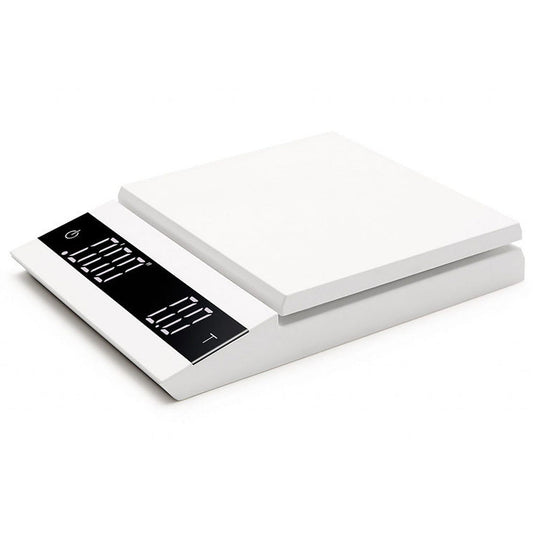What is the Ross Droplet Technique (RDT)?
Simply put, the Ross droplet technique is the act of spraying your coffee beans with a tiny amount of water before grinding them.
The technique is attributed to David Ross (for whom, this technique is named after), who is said to have suggested this on a coffee forum called Alt.Coffee back in 2005 (proposed by Andy Schecter). Although multiple sources reference this, I have never been able to find the original source myself (including digging through the usenet-alt archives), so it could very well be our modern day equivalent of a Kaldi the Goat herd story.
Regardless of the origin, adopters of this technique now choose to use a wet spoon, small spray bottle or even dedicated misting tools lightly coat the coffee beans with water before grinding them.
Why does RDT work?
To understand the answer to this question. I'm going to have to take you on a bit of a science class...
What I'm about to tell you can be found in immense detail in this study by Christopher H Hendon, Joshua Mendez Harper.
Triboelectrification
Yes, that's a real word. Here's what it means: When two things rub together, they trade tiny amounts of electrical charges, leading to becoming slightly positively charged, another becoming slightly negatively charged. There are lots of real world examples of this:
- Rub a balloon on your hair and your hair stands on end.
- Peel some cling film off of the roll and it sticks to your hand
- etc.
In coffee grinding, coffee beans rub up against each other and when they are being ground, electrons move from one surface to another. Some of these coffee particles end up positively charged, others end up negatively charged. This is what leads to those coffee fines flying everywhere (if you've ever used an EK43, you'll know what I mean). This process is exacerbated massively by grinding finer, since the amount of triboelectrification increases.
By the way, in case you were wondering, this is part of the reason why it's recommended to season new coffee grinders, as triboelectrification is strongest when two different materials rub together with no contrast.
When you season a brand new coffee grinder, you coat the burr set with a tiny layer of coffee oils, which reduces the electrical contrast between the the steel burrset and the coffee beans. This means fewer electrons exchange during the grinding process, reducing the effects of triboelectrification, leading to less clumping and less retention. This is exacerbated by brand new burrsets, because freshly machined burrs are at their sharpest, maximising the production of coffee fines. When you wear down the burr edges microscopically you stabilise the way coffee beans break apart, reducing fines.
Triboelectrification is strongest when dry, insulating materials collide - Roasted coffee is the prime candidate for building up charge. However, even a trace of moisture changes the physics completely. This is the key to understanding how RDT works.
What do the water droplets do in RDT?
When you add minuscule amounts of water during the coffee grinding process, the effect is twofold:
1. The surface of the coffee beans become lightly conductive, meaning that the charges that would otherwise have built up via triboelectrification can now dissipate instead.
When each particle carries less charge, everything becomes much more stable. Fewer particles are strongly positively charged, or strongly negatively charged, which results in less attraction (causing clumping) and less repulsion (which causes coffee grounds to fly everywhere).
2. A dusting of water encourages the fine particles to cling to larger particles through agglomeration - This is not to be confused with what we describe as clumping! Here's the key difference:
Agglomeration is when fine particles lightly attach to larger particles. This reduces the number of coffee particles floating off, through repulsion and stabilises grinding. Clumping is when strongly charged particles come together to form dense, sticky clumps - by technicality this is technically still agglomeration, but it's easier just to give them two different names when one is a good kind and the other is a bad kind when evaluating from a coffee quality of output perspective.
Does RDT affect flavour?
If you read Hendon & Mendez Harper's study (linked above), it wouldn't be appropriate to say definitively "yes RDT makes your coffee taste better", but it does make your coffee behave better, which can lead to higher extractions.
Before I go any further on this, let's get something out of the way - RDT does not alter the flavour of the coffee directly - I have seen a few independent blogs say it does, and unless done badly wrong, it will not.
For context, even a seriously generous misting of water is going to give you maybe 50mg of water, compared to the 18000mg (18g) of coffee that a typical espresso uses, which is at most 1/360th of the total weight. That amount of water is going to yield zero sensory impact. None.
What RDT does do, is reduce the static buildup and agglomerate fine particles. This makes the grinding more consistent, yielding higher quality grind particle distribution. In Hendon & Mendez Harper's study, they found that RDT produced more stable flow rates and led to higher espresso consistency. It was this that led to an increase in extractions.
The only viable claim really that can be made with regards to RDT changing the actual flavour of the coffee is that RDT does slightly reduce the temperature of the coffee as it grinds, and because heat affects particle behaviour, there may be some very small knock-on effect. But this is not the primary mechanism behind RDT, and it’s unlikely to meaningfully change flavour in normal conditions.
The other thing to note is that higher extraction does not necessarily mean better flavour, we have run some experiments before where we have achieved 27/28% extraction, and the coffees didn't taste that good at all, but generally speaking they do correlate, and a higher evenness of extraction is (it would be reasonable to say) a good thing.
In short, RDT improves the behaviour of coffee during grinding, not the chemistry of the coffee itself, and better behaviour often leads to better extractions.
Can RDT damage grinders?
I do get asked this question a lot, and I do actually see this as a valid concern that people can have because the generally affirmed logic goes: Water + Metal = Bad.
In this case, it's worth clarifying that the amount of water used is tiny. A reasonable RDT mist is maximum 50mg, which is not enough to enter the motor, cause rust or drip anywhere. Ultimately we are talking about surface moisture, tangibly no different to light dew forming on frozen beans when you take them out of the freezer or the ambient humidity changes throughout the day (especially in York).
If you do the correct process, there's no risk to your equipment. Some manufacturers even now include an RDT misting bottle in the box. But let's clarify:
Don't spray directly onto the burrs.
Don't use too much water.
Ultimately, you are the custodian of your own equipment, and if it's something you are uncomfortable with, it's totally understandable. There are other ways of mitigating static - like Plasma or Ion generators - although it should be noted that these are expensive ways of solving a problem that RDT already solves for at a very cheap price. It's argued that RDT is actually even better than Ion and Plasma generators, because RDT has a noticeable impact on agglomeration and extraction, whereas there is no evidence that I'm aware of that Ion and Plasma generators do this, since they affect coffee after grinding, not before or during. But the option is there.
How to perform RDT properly
- Weigh out your dose of coffee beans into a dosing cup.
- Apply one light mist of water from a mister or a 1–2 sprays from a spray bottle (you don't need more than this) directly onto the beans.
- Shake to distribute the moisture. The beans should look ever so slightly shiny (If they look visibly wet after shaking, you've used too much water).
- Grind.
Note well, coffee roasters and coffee shops of the world!
Please, do not use RDT when grinding bags of coffee for customers! Even though you are only introducing micro amounts of water into the system, please be diligent that using RDT before grinding coffee for a customer is a no-no!
What are the drawbacks of RDT?
So interestingly, Hendon & Mendez Harper's study found no measurable downsides to performing RDT. There was no negative impact on grinder function, on flavour, on extraction or consistency. In fact, for all of these, the opposites were true:
Grinders can operate at a higher feed rate without increasing mess or variance. The moisture from RDT flattens the distribution of charged particles, leading to fewer extremely charged particles. The extractions became more consistent and higher extractions were recorded.
Not to be that guy, but there are really no noticeable downsides to using RDT, other than it takes a few more seconds to perform.
Conclusion
To conclude, RDT (Ross Droplet Technique) is one of the simplest and cheapest ways to reduce static, mess, clumping and retention, while increasing your extraction consistency.
FAQs
Do I need RDT for every grinder?
Not really. Some grinders like the DF83V produce very little static (for more information on this, see our blog on the best filter coffee grinders), especially slow-RPM conicals or large commercial burr sets. But for single-dosing grinders, high-speed flats (EK43 etc.) RDT makes a dramatic difference. So no, you don't need it, but in certain situations, it can make a massive difference.
Does RDT help for filter coffee, or just espresso?
It helps with both. The extraction benefits are more noticeable in espresso, but the effect of minimising static is consistent across espresso and filter.
Will RDT cause my grinder to rust?
If done properly, no. The amount of water used is so small (25–50mg) that it evaporates or just sticks to the bean surface. This isn't enough to cause corrosion, and it's likely that you expose your grinder to more humidity just by living in a humid climate.
Does RDT affect particle size distribution?
Indirectly, yes. RDT doesn’t change the burr geometry, but it does flatten the distribution of charged particles, so fewer particles become extremely positively or negatively charged. This results in agglomeration of fines, resulting in fewer stray fines floating off by themselves.
Does grinder RPM affect static?
A bit, but not nearly as much as moisture does. Higher RPM produces slightly more fines (on flat and conical burrs) and more charge. Lower RPM produces slightly less. But the effect is small compared to roast level, bean moisture, burr geometry, or RDT.
Does roast level affect static?
Yes, roast level has an impact on how much static your coffee produces via triboelectrification. Darker roasts generate more static than lighter roasts on average. This is because darker beans are drier and produce more fines during grinding. More fine particles mean more surfaces rubbing together, which increases triboelectric charge. Light roasts, conversely, contain more internal moisture and are denser, so they generate less charge overall.
Can I use RDT with a hopper of beans?
No, please don't do that. RDT is a protocol designed with single dosing in mind, where it is easier to do consistently and evenly.
Take your brewing game to the next level:
Espresso lovers can also find our guide on the Best Coffee Tampers here.
Filter coffee lovers can find our guide on the Best Pourover Filter Coffee Recipes here.
Find some of the best free tools to accompany your brews here.
Find your perfect coffee from Harmony's selection of coffee beans here.
Check out our guide on resting coffee to get the most out of your brews here.
Find the Best Coffee Scales here.
Find the Best Filter Coffee Grinders for Home here.
Love what we do here?
Consider a Harmony coffee subscription for your home or office!
Alternatively check out our coffee offerings here to find your new favourite coffee!












